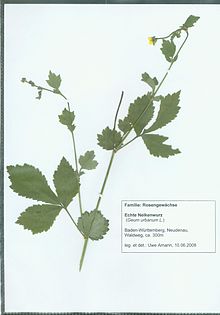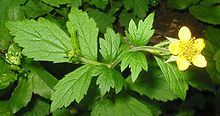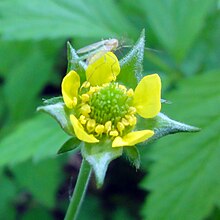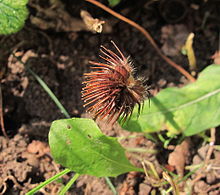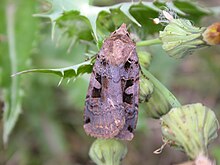Real clove root
| Real clove root | ||||||||||||
|---|---|---|---|---|---|---|---|---|---|---|---|---|
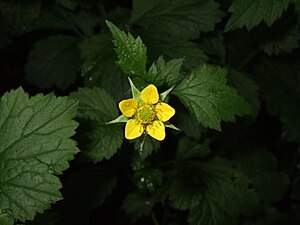
Common clove root ( Geum urbanum ) |
||||||||||||
| Systematics | ||||||||||||
|
||||||||||||
| Scientific name | ||||||||||||
| Geum urbanum | ||||||||||||
| L. |
The avens ( Geum urbanum ), also Common Avens called, is a kind from the kind of Geum ( Geum ) that the family of the rose family belongs (Rosaceae).
The scientific generic name Geum is probably based on the Greek word γεῦμα geuma , which means the taste of something and refers to the clove odor of the roots, which is also referred to by the German common name clove root . The roots contain about 0.15% eugenol , which is created when the roots are damaged by the enzymatic conversion of the glycoside Gein . Eugenol is the main component of clove oil . The specific epithet urbanus means urban and indicates frequent growth places of the plant in the vicinity of settlements. The real clove root was previously used as a medicinal plant, grown in monastery gardens and used as an additive in herbal liqueur . Their common name, Benedictine herb, reminds of this .
description
general characteristics
The real carnation grows as a perennial , evergreen , herbaceous plant that reaches heights of about 30 to 120 cm. Since the persistence organs are close to the surface of the earth, the common carnation is counted among the hemicryptophytes . An upright, thick and short, 3 to 4 rarely up to 7 centimeters long and 1 to 2 centimeters wide rhizome serves as the storage organ , which also ensures vegetative reproduction . It is shaped like a beet and colored brown-yellow on the outside. Seen in cross section, it has a dark purple center. Characteristic is the rich rooting and the stocking with root and leaf remains. The roots contain the glycoside Gein, which is broken down by the enzyme gease into eugenol and the disaccharide vicianose. Eugenol smells intensely of cloves and is a component of several essential oils, such as clove oil or allspice oil. The stem axis is divided into a compressed rosette-forming and an elongated leaf-bearing section, which is why the true carnation root is assigned to the semi-rosette plants.
Appearance
The real clove root has an upright growth. The moderately broad to slender stem axis grows branched. It has fine edges and a brownish red color. It is more or less densely covered with long and short hair.
leaves
The basal leaves, arranged in a rosette , arise from the rhizome. They are long-stalked. The length of the petiole is usually about 10 centimeters, but it can also be 15 to 18 centimeters. The petiole is hairy and has grooves. The leaf blade develops a length of up to 14 centimeters. It varies in shape from obovate to ovoid . It is irregularly pinnate , often with a pair of leaflets, sometimes with two to three pairs of larger leaflets . With an average length of 6 (-10) centimeters, the terminal leaflet is significantly larger than the lateral leaflet. The upper side of the leaflets is hairy, the underside of the leaf is hairy, especially on the veins. The lateral leaflets are lobed, the leaf margin can be serrated twice or irregularly serrated and notched. The blade of the terminal leaflet is three to five times lobed, sometimes deeply incised.
The short-stalked stem leaves with three-fold leaflets are arranged alternately on the stem axis. They appear after the basal leaves. In the lower stem section they resemble these and then continuously decrease in size towards the top. The uppermost stem leaves are indistinctly designed with three lobes and a notched edge. Typical of the avens are the striking large stipules . These are located at the base of the petiole of the stem leaves. They have an approximately rounded shape and are structured like leaves. The leaf margin is serrated.
Inflorescence and flower
The inflorescence stems arise from the axils of the basal leaves. The bright yellow flowers are grouped together in a loose, sparsely branched, few-flowered cyme . The flowers are upright in the cymes. The single flower has a long stem. This is densely covered with long and short hair. The flowers of the common carnation are radial symmetry. They can be hermaphroditic, male or female. Here, on the one hand, male and hermaphrodite flowers occur together on one plant, which corresponds to the andromonocial distribution , on the other hand, the flowers are also androdiacal , that is, hermaphrodite and male flowers grow on different plants. Specimens with all-female flowers were also found. The five-fold flower of the true carnation has a double perianth . In front of the calyx is a narrow green outer calyx , the lanceolate segments of which develop a length of 2 to 5 millimeters and a width of about 5 millimeters. The five green, externally hairy sepals have a broad triangular shape. Their length varies between 4 and 7 millimeters. At flowering time they are spread out against the flower, at fruiting time they are repulsed. The five bright yellow rounded, narrow obovate petals are about 3 to 6 millimeters long. They fall off soon after they bloom. Stamens are abundant. 60 to 80 very small free carpels stand on the curved flower axis. The ovaries are superordinate and hairy. The terminal purple-colored stylus is divided into two parts. The lower hook-shaped part is bare, the upper part goes from the hook tip and is more or less feathery hairy. The flowering period extends from May to October.
fruit
The numerous carpels develop into small hairy nuts . These are located on the cone-shaped flower axis, which is greatly enlarged at the time of fruiting. The elongated and hardened style remains on the fruit. In the upper third, at the point where the stylus is kinked, there is a delicate separating fabric, from which the shorter, upper stylus is detached when the fruit is ripe. The hook-shaped, curved stylus remains on the fruit.
Chromosome set
The true carnation root is a polyploid species. Based on the basic chromosome number of the genus Geum of x = 7, it is hexaploid with a chromosome number of 2n = 42.
ecology
Pollination ecology
In the hermaphrodite flowers of the true carnation, the female genital organs - stylus and stigma - ripen before the male reproductive organs, the anthers, although the male and female flower phases overlap for a longer period of time. This mechanism, botanically called weak proterogyny , easily promotes cross- pollination compared to self-pollination . Since the innermost stamens ripen at the same time as the outer style, spontaneous self-pollination is also promoted. In comparison to self-pollination, cross-pollination occurs rather rarely in the common carnation. According to Kugler , the real carnation is a nectar-carrying disc flower. The nectar is offered half-covered in the flower center and secreted there between the stamens. The insect visit is only sparse. Flies , hover flies , and beetles usually seek out the flower.
Propagation ecology
The hook-shaped, lignified stylus remnant has an important function for the epichore spread. Since the handle hook is directed outwards, the nuts can be stripped off by passing animals. As hook and loop fasteners , they stick to the fur of cattle, sheep or fallow deer, for example, and are spread further. They can also be kidnapped with human clothing. Through its rhizome, the common carnation root is also able to reproduce vegetatively , a form of self- propagation in the broad sense.
Synecology
The avens is the caterpillars of some butterfly species polyphag as fodder plant, the Dark Waldschatteneule ( Rusina ferruginea ), the mountain forest-blade tensioner ( Xanthorhoe montanata ), the four-banded blade tensioner ( Xanthorhoe quadrifasiata ) and the Triangle Erdeule ( Xestia triangulum ).
Occurrence
distribution
The common clove root has native occurrences in North Africa , in temperate Asia and in Europe . In detail, stocks are documented in the following areas:
In North Africa, the common clove root is represented in Algeria, Morocco and Tunisia.
Occurrences in Turkey, Iraq and Iran are known from West Asia. In the Caucasus, the common clove root is documented in Armenia, Azerbaijan, Georgia as well as in Ciscaucasia and Dagestan (Russian Federation). Central Asia has stocks in Kazakhstan, Kyrgyzstan, Tajikistan and Turkmenistan.
Northern European occurrences are known from Denmark, Finland, Ireland, Norway, Sweden and Great Britain. In Central Europe, the common carnation is represented in Austria, the Czech Republic, Germany, Hungary, the Netherlands, Poland, Slovakia and Switzerland. In Eastern Europe it is valid in Estonia, Latvia, Belarus, Russia and Lithuania. South-Eastern Europe has occurrences in Albania, Bosnia-Herzegovina, Bulgaria, Croatia, Greece, Italy, Macedonia, Montenegro, Romania, Serbia and Slovenia. In South-West Europe, growth places can be found in France with Corsica, Spain and Portugal.
In Germany, the common carnation is found in all federal states. The occurrences in Austria are considered frequent in all federal states. In Switzerland, except in high mountain areas, the common carnation is also widespread up to (especially in the northwest) frequent.
The common avens is naturalized in Australia and New Zealand.
Location
The somewhat warmth-loving clove root prefers light, fresh, herbaceous oaks - hornbeam forests and alluvial forests . It is a regular companion on partially shaded forest paths and clearings . It is also typically found in bushes and fringes . Shady, nutrient-rich ruderal corridors in cities are also one of the regular habitats. The common carnation needs nutrient-rich soil at its locations. In the Alps, the species climbs up to 1000 meters. Dörr and Lippert also report an occurrence on the Pointalpe near Hinterstein in Bavaria at 1,320 meters above sea level.
The main occurrence of the common carnation is in nutrient-rich herbaceous and perennial weed meadows. Deciduous and fir forests in medium-sized locations are considered minor occurrences.
Plant sociology
The true clove root is a characteristic species of the order basal society of nitrophytic fringes Glechometalia hederaceae Tx. in Tx. et Brun-H. Within this order, together with the garlic mustard , it forms the determining species of the association of clove-garlic mustard fringes (Geo-Alliarion). These borders accompany woody plants or are formed in clearings in shady to partially shaded locations. This association can often also be found at corresponding ruderal locations. The common clove root has its main occurrence in the order of hedges and bushes (Prunetalia Tx.) And in the order of beech and deciduous mixed forests (Fagetalia sylvaticae Pawl.).
Systematics
The species Geum urbanum L. was first published in 1753 by Carl von Linné in Species Plantarum , page 501 . Is synonymous Geum rival subsp. urbanum Á. Löve & D. Löve .
The common bastard Geum rivale × Geum urbanum is called Geum × intermedium Ehrh. designated. It occurs in Europe and Turkey.
use
Medicinal plant
For the pharmacological drug, rhizomes and roots of the clove root are used ( Caryophyllatae rhizoma "clove root "). The main active ingredients are tannins, mainly gallotannins , as well as ellagitannins and catechin tannins ; there are also various phenol carboxylic acids (besides gallic acid and ellagic acid also caffeic acid , chlorogenic acid and protocatechuic acid ). The drug contains small amounts of essential oil , which is mainly composed of eugenol . In the intact plant, eugenol is present in the glycoside gein , the sugar component of which is vicianose, a disaccharide made from glucose and arabinose . Under the action of the plant's own enzyme Gease , it is hydrolyzed and the aglycon is released, for example when the plant is injured or when parts of the plant are cut or dried.
The focus is on the tanning effect, which is supported by the antiseptic properties of eugenol. The dried roots and the rhizomes were used as medicinal drugs, whereby, according to Hegnauer Gein, mainly occurs in the roots and the content in the rhizomes is negligible.
In ancient times, the real clove root was used as a medicinal plant. Pliny recommended it for chest problems, for St. Hildegard she was an effective aphrodisiac . In the Middle Ages and early modern times, for example, it was used for jaundice, dropsy and abdominal colic. Further names of the plant were sanamunda (or "Sanamundenkraut") and "Heil aller Welt". At herbal priest Künzle , the real clove root was used for meningitis , bladder weakness or toothache . It is no longer used in herbal medicine today. Due to its tannin content, it is recommended as an addition to gastrointestinal teas. In homeopathy it is used for inflammation of the urinary bladder and urethra. The drug is still occasionally used in folk medicine today. It is used for diarrhea , indigestion, as a gargle for inflammation of the mouth and throat, as a bath additive for chilblains and hemorrhoids , and for skin diseases as a poultice or as a wash.
consumption
In the past, the roots were used to flavor wine and beer. This addition was also seen as a suitable means of counteracting possible acidification. They are also used to flavor liqueurs (Benedictines) and in cosmetics as an additive to toothpastes and mouthwashes. Young leaves can be used as mixed vegetables and salad.
Popular belief
Due to the strong scent, the real clove root has an anti-demonic effect. Powdered roots were added to maleficent powder , a remedy for witches and devils.
photos
Individual evidence
- ↑ a b Ben-Erik van Wyk, Coralie Wink, Michael Wink: Handbook of medicinal plants. Wissenschaftliche Verlagsgesellschaft Stuttgart, 2004, ISBN 3-8047-2069-2 , p. 157.
- ↑ a b c d Ingrid Schönfelder, Peter Schönfelder: The new manual of medicinal plants. Special edition. Franckh-Kosmos, Stuttgart 2011, ISBN 978-3-440-12932-6 , pp. 214-215.
- ^ A b c Wolfgang Adler, Karl Oswald, Raimund Fischer: Excursion flora from Austria . Ed .: Manfred A. Fischer. Eugen Ulmer, Stuttgart / Vienna 1994, ISBN 3-8001-3461-6 , p. 386 .
- ↑ a b c d e f g Eckehart J. Jäger, Klaus Werner (Ed.): Exkursionsflora von Deutschland. Founded by Werner Rothmaler. 18th, edited edition. Volume 2. Vascular Plants: Baseline, Spectrum, Heidelberg a. a. 2002, ISBN 3-8274-1359-1 , p. 266.
- ↑ a b c d e f g h i C. J. Webb, WR Sykes, PJ Garnock-Jones: Flora of New Zealand. Volume IV: Naturalized Pteridophytes, Gymnosperms, Dicotyledons. 1988, ISBN 0-477-02529-3 , (online) .
- ↑ a b c d e f Biolflor. Database of biological-ecological characteristics of the flora of Germany. Geum urbanum ( Memento of the original from March 4, 2016 in the Internet Archive ) Info: The archive link was inserted automatically and has not yet been checked. Please check the original and archive link according to the instructions and then remove this notice. .
- ↑ a b c d e f Angelika Lüttig, Juliane Kasten: Rosehip and Co. Flowers, fruits and spread of European plants . Fauna-Verlag, Nottuln 2003, ISBN 3-935980-90-6 , p. 286-287 .
- ↑ a b Sven Dienstbach: Portrait of the real Nelkenwurz- Langenbach: Flora - native plants
- ↑ a b c d e Real carnation root. In: FloraWeb.de.
- ↑ a b c d e f Ruprecht Düll , Herfried Kutzelnigg : Pocket dictionary of plants in Germany. A botanical-ecological excursion companion to the most important species . 6th, completely revised edition. Quelle & Meyer, Wiebelsheim 2005, ISBN 3-494-01397-7 , p. 223 .
- ↑ Eckehart J. Jäger, Klaus Werner (Ed.): Exkursionsflora von Deutschland. Founded by Werner Rothmaler. 18th, edited edition. Volume 2. Vascular Plants: Baseline, Spectrum, Heidelberg a. a. 2002, ISBN 3-8274-1359-1 , p. 36.
- ↑ Federal Agency for Nature Conservation (Ed.): The real avens in their meaning for butterflies. Database at FloraWeb .
- ^ A b c Geum in Germplasm Resources Information Network (GRIN), USDA , ARS , National Genetic Resources Program. National Germplasm Resources Laboratory, Beltsville, Maryland. Retrieved April 17, 2017.
- ^ Geum urbanum. In: Info Flora (the national data and information center for Swiss flora).
- ↑ Erhard Dörr, Wolfgang Lippert : Flora of the Allgäu and its surroundings. Volume 2, IHW, Eching 2004, ISBN 3-930167-61-1 , p. 65.
- ↑ Heinrich E. Weber: Bushes, hedges, herb edges. Eugen Ulmer, Stuttgart (Hohenheim) 2003, ISBN 3-8001-4163-9 , p. 171.
- ↑ Carl von Linné: Species Plantarum. Volume 1, Lars Salvius, Stockholm 1753, p. 501 ( digitized version ).
- ^ Geum urbanum , synonyms at Tropicos.org. Missouri Botanical Garden, St. Louis
- ^ Alfred Becherer, Christian Heitz: School and excursion flora for Switzerland. Taking into account the border areas. Founded by August Binz. 17th edition. Schwabe & Co., Basel 1980, ISBN 3-7965-0832-4 , p. 213.
- ↑ a b R. Hegnauer: About the glycoside Gein (= geoside) in the genus Geum . In: Phyton , 5, 1954, pp. 194-203, PDF .
- ↑ Adam Lonitzer : Kreuterbuch. Artificial conterfeytunge of trees, shrubs, hedges, herbs, grain, Gewuertze [...]. Edited by Peter Uffenbach, (Frankfurt am Maion 1557, further edition there 1630; last edition Augsburg 1783) Ulm an der Donau 1679; New print (Leipzig 1934 and by) Konrad Kölbl, (Grünwald near) Munich 1962, p. 289 ("Benedictenwurtz, Garyophyllata [...], Naeglinkraut, [...] Sanamunda [...] is the water addicts [..] .] very useful ”).
- ↑ a b c Manfred Boksch: The practical book of medicinal plants , BLV Verlagsgesellschaft München, 4th edition 2003, ISBN 3-405-14937-1 , page 149
- ↑ Felix Grünberger: The herbs in my garden. Freya, Linz 2006, ISBN 3-902134-79-8 , p. 418.
Web links
- Real clove root. In: FloraWeb.de.
- Profile and distribution map for Bavaria . In: Botanical Information Hub of Bavaria .
- Geum urbanum L. In: Info Flora , the national data and information center for Swiss flora . Retrieved November 8, 2015.
- Distribution in the northern hemisphere from: Eric Hultén, Magnus Fries: Atlas of North European vascular plants. 1986, ISBN 3-87429-263-0 at Den virtuella floran. (swed.)
- Thomas Meyer: Data sheet with identification key and photos at Flora-de: Flora von Deutschland (old name of the website: Flowers in Swabia )
- Literature on Geum urbanum in the Kew Bibliographic Databases (English)
